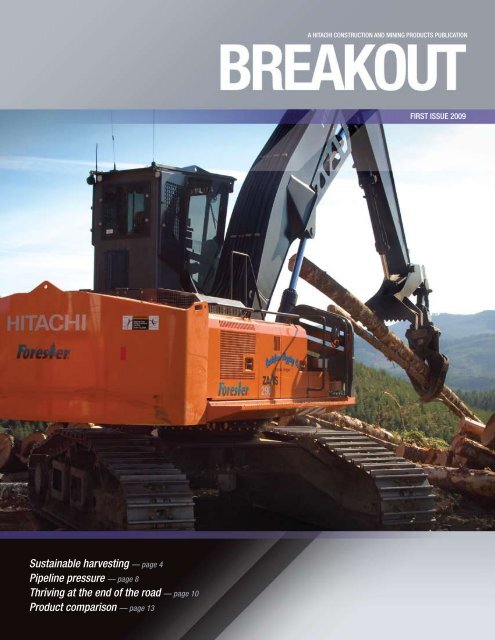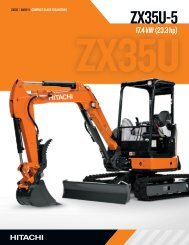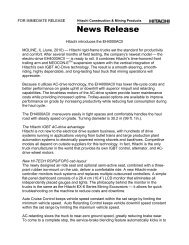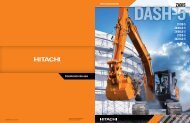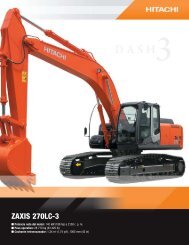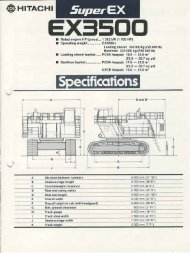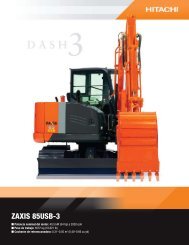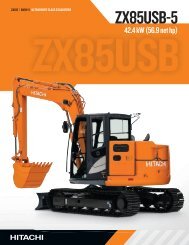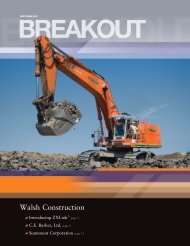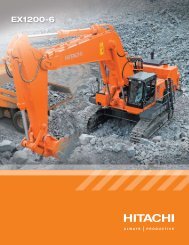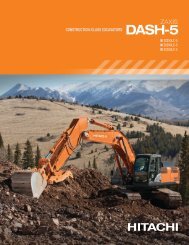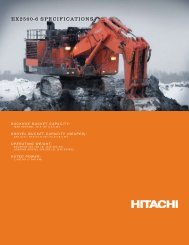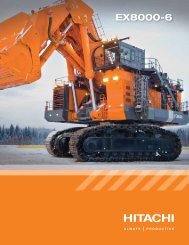Issue 1 - Hitachi
Issue 1 - Hitachi
Issue 1 - Hitachi
Create successful ePaper yourself
Turn your PDF publications into a flip-book with our unique Google optimized e-Paper software.
A HITACHI CONSTRUCTION AND MINING PRODUCTS PUBLICATION<br />
FIRST ISSUE 2009<br />
Sustainable harvesting — page 4<br />
Pipeline pressure — page 8<br />
Thriving at the end of the road — page 10<br />
Product comparison — page 13
ON<br />
the<br />
INSIDE<br />
Navigating the rough economic current<br />
Gloomy forecasts and<br />
a general sense of unease<br />
are definitely in fashion<br />
these days. Recent volatility<br />
in the financial markets<br />
is largely responsible, of<br />
course. Weighing options<br />
and deciding how to navigate<br />
the predicted choppy<br />
economic seas in 2009 is<br />
a daunting task for contractors<br />
and equipment<br />
manufacturers alike.<br />
Although I can’t offer you specific advice on how to<br />
guide your company through these uncertain times, I<br />
want to stress that our strong <strong>Hitachi</strong> dealer network<br />
will continue to place you in the equipment you need,<br />
while delivering the service and support you’ve come<br />
to expect.<br />
<strong>Hitachi</strong> will continue to provide you with the<br />
equipment for your unique needs during these uncertain<br />
times. John Deere Credit will continue to provide<br />
unique financial solutions to assist you in protecting<br />
your cash flow. John Deere has been serving customers<br />
for more than 170 years. So, you can count on<br />
the solid foundation and backing of John Deere<br />
Credit. We value your business and understand that<br />
by working together to build lasting relationships,<br />
we all succeed.<br />
Together, we remain committed to you.<br />
Luke Gakstatter,<br />
Director, <strong>Hitachi</strong> Construction Products<br />
Factory-backed<br />
security<br />
T<br />
here’s enough day-to-day stress in<br />
the construction business without<br />
worrying about unpredictable machinerepair<br />
expenses. That’s why you owe<br />
it to yourself — and your bottom line<br />
— to find out about the various <strong>Hitachi</strong><br />
Extended-Coverage warranties.<br />
Extended-Coverage warranties are<br />
factory-backed and flexible enough<br />
to meet the needs of any business or<br />
Extended-coverage warranties are honored<br />
by all <strong>Hitachi</strong> dealers.<br />
government agency. They are a valuable<br />
management tool because they give you<br />
fixed costs for machine repairs over a<br />
given period of time.<br />
The Standard warranty on construction<br />
machines under 100 horsepower<br />
is designed to cover all failures due to<br />
defect in workmanship or materials for<br />
the first 12 months after delivery, free<br />
of charge. For units 100 horsepower<br />
and higher, coverage is for the first six<br />
months, again free of charge.<br />
But many owners feel they need more<br />
protection. So we offer Full Machine<br />
and/or one of three Powertrain options<br />
(Powertrain Plus Hydraulics, Powertrain,<br />
or Engine Only). Maximum coverage<br />
ranges from 500 to 10,000 hours<br />
and 12 to 84 months.<br />
The exclusive StructurAll warranty<br />
provides three years or 10,000 hours<br />
(whichever comes first) of “no-fear”<br />
coverage on major machine structures<br />
as installed at the factory free of charge<br />
— including booms and mainframes.<br />
Our Extended-Coverage warranties<br />
are honored by all <strong>Hitachi</strong> dealers.<br />
They go where your machines go and<br />
can be redeemed for service at any<br />
North American dealership. They can<br />
be transferred when you sell or trade<br />
the unit. And financing is available<br />
through <strong>Hitachi</strong> finance programs.<br />
All you need to do is perform<br />
scheduled maintenance as outlined in<br />
the Operator’s Manual and Extended-<br />
Warranty contract, and keep accurate<br />
maintenance records. Fluid analysis<br />
is required on most machines with<br />
new Extended-Warranty contracts<br />
or extensions.<br />
So if you’re ready for some extra<br />
protection, contact any branch location<br />
for more information about the <strong>Hitachi</strong><br />
Extended-Coverage warranties.<br />
3
ONLINE VIDEO<br />
ONLINE VIDEO<br />
ONLINE VIDEO<br />
Sustainable<br />
harvesting<br />
“W<br />
e’re a family-owned business,”<br />
says Mark Gustafson, coowner<br />
of Gustafson Logging. “We’ve<br />
been operating for about 34 years now<br />
in Northwest Oregon’s Coast Range,<br />
primarily for commercially owned<br />
timberlands.<br />
“Our business philosophy is to<br />
make ourselves as productive as possible<br />
while outputting quality logs and<br />
timber products — the kind the people<br />
we work for want to see on a regular<br />
basis. And to maximize production<br />
on a sustainable, regular basis, you’ve<br />
got to keep up the quality of your<br />
work. That means not only producing<br />
logs, but taking care of the environment.<br />
Doing all the things that are<br />
required, not only by regulation, but<br />
by simply being a good steward of the<br />
ground so we can prepare the way for<br />
future harvests.”<br />
Mark Gustafson, Co-owner, Gustafson Logging<br />
Gustafson continues, “We’re working<br />
on private ground, so there are<br />
stipulations the timber companies must<br />
follow as they try to be as ‘green’ or as<br />
sustainable as possible. They have all<br />
become Sustainable Forest Initiative<br />
(SFI) certified. Places like The Home<br />
Depot ® will buy lumber only from<br />
timber companies that are SFI certified.<br />
In other words, they’re not overcutting<br />
their stock, and they’re not razing<br />
the land in any cut-and-run manner.<br />
They’re in it for the long haul.<br />
“Consequently, loggers on the property<br />
must work within the constraints<br />
of that certification. We have to be<br />
certified as professional loggers. To do<br />
that, we must take a certain amount<br />
of classroom instruction on an annual<br />
basis through seminars and meetings<br />
put on by either the State Department<br />
of Forestry or the Association of Oregon<br />
Loggers. It’s just like keeping your<br />
teachers’ certification current. You have<br />
to keep up to date with new changes<br />
and regulations ranging from road<br />
construction and harvest practices.<br />
In other words, today’s timber companies<br />
aren’t going to hire somebody<br />
who’s not good at what they do. And<br />
a logging company’s not going to stay<br />
in business unless they’re good at what<br />
the timber companies want done on<br />
their property — so they can stay in<br />
compliance … and therefore be able<br />
to sell their lumber.”<br />
The Gustafsons feel they serve their customers<br />
best and make more profit by replacing their<br />
log loaders and delimbers every 7,000 hours.<br />
Jobs with 30-degree-plus slopes are cut by<br />
hand. The timber is then brought to a landing<br />
with cable yarders.<br />
A stable crew is essential. The Gustafsons<br />
feel fortunate to have a number of long-term<br />
employees. Their company and crew were<br />
even featured on the History Channel series<br />
“The Ax Men.”<br />
4 5
“I was part of the Customer Advocacy Group<br />
developed by DHSP, builder of the <strong>Hitachi</strong><br />
and Deere forestry units. When it was decided<br />
to come out with a new series, DHSP brought<br />
the group to the plant, where we brainstormed<br />
with their engineers. The result is a machine<br />
with the features we felt were important. This<br />
new series is fuel-efficient, responsive, and<br />
tough. The cab was already great, but now<br />
it’s even better.”<br />
Clay Gustafson, Co-owner, Gustafson Logging<br />
In order to be as productive as possible,<br />
Gustafson Logging has been relying<br />
on <strong>Hitachi</strong> forestry equipment for<br />
the past 10 years.<br />
“Ten years ago we decided that there<br />
were certain pieces of equipment that<br />
you could run for an extended amount<br />
of time,” explains Gustafson. “Our<br />
yarders, for example, are a long-term<br />
investment. Log loaders and stroke<br />
delimbers are critical as they need to<br />
be running all the time. If they stop,<br />
the meter keeps ticking as long as the<br />
crew is on the job. And if they stop,<br />
production stops. So, we trade every<br />
7,000 hours. Interestingly, our productivity<br />
has increased 15 percent and our<br />
maintenance costs have decreased 40<br />
percent, so the practice has dramatically<br />
improved our bottom line. You<br />
hear about others who might boast of<br />
having 20,000 hours on a log loader,<br />
but with our common radio setup, you<br />
hear talk about breaking down.”<br />
“Years ago,” says Clay Gustafson,<br />
Mark’s brother and co-owner, “we<br />
got introduced by LinkBelt to the Isuzu<br />
engine. Then, we moved to the Deere<br />
2554 Log Loader. We were and still are<br />
quite impressed with that loader built<br />
by DHSP. But, we missed the Isuzu<br />
engine. We think it has the best fuel<br />
economy and lowest maintenance costs.<br />
Moving on to the <strong>Hitachi</strong> provided the<br />
best of all worlds. It’s a DHSP product<br />
with an Isuzu engine. Another reason<br />
we like working with the DHSP product<br />
is our dealer, Papé Machinery. The<br />
financing options available through<br />
them and John Deere Credit are excellent.<br />
It’s a strong dealership with great<br />
product support. They don’t walk on<br />
water, but they are excellent.”<br />
Gustafson Logging Inc. is serviced by Papé<br />
Machinery, Portland, Oregon.<br />
“We’re incredibly happy with our new<br />
<strong>Hitachi</strong> 290-3 log loader. It’s fast [and]<br />
very efficient. The operator has been<br />
singing its praises since Day One.”<br />
— Clay Gustafson, Co-owner<br />
6 7
Pipeline pressure<br />
A year’s work in three months<br />
Packages of multiple-diameter pipe, insulated<br />
and exposed, make the job even more difficult.<br />
“W<br />
e’re a pipeline utility company,”<br />
says Rob Shipway, general<br />
manager of Fabcor in Grande Prairie,<br />
Alberta. “We lay two-inch right up to<br />
24-inch pipe for the oil and natural gas<br />
industry,” says Rob Shipway, general<br />
manager of Fabcor, Grande Prairie,<br />
Alberta. “We run about 120 pieces of<br />
track iron throughout Alberta and British<br />
Columbia, and we work a lot going<br />
through the tough Canadian Rockies.<br />
So, we utilize our <strong>Hitachi</strong> excavators to<br />
the fullest.”<br />
Because of the soft, wet conditions<br />
in the lowlands of Alberta and British<br />
Columbia, all pipelines with any distance<br />
to them are worked during the<br />
winter, after the ground has frozen.<br />
“Eighty percent of our year’s work<br />
is done during the three months of<br />
January through March,” adds Shipway.<br />
“So we’ll go from a skeleton<br />
crew of around 100 to 500–600 employees<br />
and contract workers. We also<br />
go from an easy-going attitude to one<br />
of intense pressure.”<br />
Although the drop in crude prices<br />
has caused the industry to slow down,<br />
It’s a two- to three-kilometer march each day<br />
through soil conditions ranging from muskeg to<br />
hard rock.<br />
the larger pipe market is still strong.<br />
“We’re looking at 70 kilometers of<br />
24-inch pipe for this winter in the Fort<br />
Nelson, British Columbia, area. That’s<br />
where the big plays have been this year,<br />
and the pipeline is needed to complete<br />
the effort,” says Shipway.<br />
It’s a fascinating problem getting<br />
ready for the annual stretch of intense<br />
Joe Bachand, Fabcor Equipment Manager, Rob Shipway, General Manager, and Darren Kutschinski, Wajax<br />
Sales Representative. The Fabcor fleet of <strong>Hitachi</strong> excavators can grow to 70 during their winter three-month<br />
winter stretch.<br />
activity because the jobs often aren’t<br />
locked in until late fall. So the company<br />
must begin preparation for work<br />
they believe will come, but for which<br />
they have no signed contracts in hand.<br />
Needless to say, this is an industry that<br />
relies heavily on trustworthy equipment<br />
suppliers.<br />
“My choice of <strong>Hitachi</strong> is based<br />
on two things,” says Shipway. “First,<br />
Wajax, our <strong>Hitachi</strong> dealer, is tuned<br />
into our needs as a pipeliner. Although<br />
we have around 25 excavators of our<br />
own, we usually end up with as many<br />
as 70 on the job by mid-January. These<br />
are excavators we’ve either rented from<br />
Wajax for the three months or owneroperators<br />
who have their own <strong>Hitachi</strong><br />
units. Wajax gears up for the winter<br />
work with extra parts and replacement<br />
machines. The people at Wajax, from<br />
top management down, understand<br />
that when we need something, we need<br />
it now.<br />
“The second reason is that <strong>Hitachi</strong><br />
’hoes are the most dependable. And I<br />
think the <strong>Hitachi</strong> ZX350LC-3 is the<br />
best overall excavator on the market<br />
when you look at balance, reach, and<br />
power. The operators definitely do love<br />
the <strong>Hitachi</strong> cab. And I guess everybody<br />
knows that <strong>Hitachi</strong>’s fuel efficiency<br />
definitely saves money.<br />
“Pipeline construction is much like<br />
a factory,” says Shipway. “There’s a<br />
process to it. It’s very repetitious. On<br />
that 70-kilometer job, we’ll get it down<br />
to a two- to three-kilometer-a-day<br />
march. That’s from grade to stringing<br />
to welding to cleanup. So, you’re talking<br />
about covering a lot of ground in<br />
a hurry. If one part of the operation<br />
fails, we don’t get our production. And<br />
that’s the whole thing — you’ve got to<br />
get in and out with your iron and keep<br />
it working.”<br />
Fabcor is serviced by Wajax Industries of<br />
Grande Prairie and Edmonton, Alberta.<br />
8 9
Thriving at the<br />
end of<br />
the road<br />
Located at the southernmost end<br />
of the Alaskan Highway, the<br />
picturesque town of Homer attracts<br />
adventure seekers, independent types,<br />
and colorful nicknames like “Cosmic<br />
Hamlet by the Sea,” “Halibut Capital<br />
of the World,” and “End of The Road.”<br />
The last was bestowed by famed storyteller<br />
and Motel 6 ® spokesman Tom<br />
Bodett, who once made the small town<br />
his home. What many people may<br />
not know was that Bodett worked in<br />
construction before he turned writer<br />
and raconteur.<br />
“Yeah, I knew Tom,” says Ray Clapp,<br />
President, Coast Range Construction,<br />
Inc. “Tom moved here from Michigan.<br />
He was an independent building contractor<br />
and I was a carpenter. That was<br />
in the 1980s. Of course, Tom hit the big<br />
time and later moved to Vermont.”<br />
Like Bodett, Clapp migrated to<br />
Alaska from the lower 48. Originally<br />
from Oregon, Clapp always wanted to<br />
go to the Land of the Midnight Sun, so<br />
he put his tools, hang glider, and kayak<br />
on top of his truck and headed north.<br />
He drove all around the state and even<br />
worked in the bush, but decided he<br />
liked Homer best and settled there.<br />
Where Land and Sea Meet<br />
Clapp’s construction company, one<br />
of a competitive handful in the area,<br />
specializes in setting foundations for<br />
Ray Clapp, President, Coast Range Construction<br />
lodges and cabins and doing house-site<br />
development for contractors. Taking<br />
advantage of the barge and ferry terminals<br />
in the area, as well as the highway,<br />
Clapp is able to move his equipment<br />
wherever the job might be. What distinguishes<br />
his company from the others<br />
is what he calls his secret weapon —<br />
a <strong>Hitachi</strong> ZX200LC equipped with a<br />
Helac ® quick-coupler.<br />
“With the help of CMI, our area<br />
<strong>Hitachi</strong> dealer, we put two sets of hydraulic<br />
piping on the machine. One set<br />
is high-pressure low-flow, and the other<br />
is low-pressure high-flow. That way, I<br />
can run all kinds of attachments, and<br />
do whatever it takes to do the job.<br />
“I even have a small vibratory plate<br />
hammer for pile driving in tight areas.<br />
Usually, I can work from the land, but<br />
sometimes we drive in dock pilings<br />
using a barge as the platform. The<br />
200 is a lot cheaper than bringing in<br />
a large crane with a large hammer on<br />
a big barge.”<br />
Failure is Not an Option<br />
Coast Range’s 200 has about 8,000<br />
hours on it. To protect his investment,<br />
Clapp decided he needed a second<br />
ZX200LC — one for everyday digging<br />
and stumping. He equipped it with a<br />
more traditional quick-coupler and a<br />
thumb-equipped bucket.<br />
“I’ve owned an EX-3, an EX-5,<br />
and several ZX-1s. I’ve rented others,<br />
including a ZX350LC-3. We’ve not had<br />
trouble with any of them. That’s the<br />
reason I keep going back to <strong>Hitachi</strong>.<br />
We’ve just never had any failures. I’ve<br />
had other brands of excavators, and<br />
downtime kills you. You’ve got to have<br />
something that starts up day in and day<br />
out. No matter how cold it gets, the<br />
<strong>Hitachi</strong> units fire up in a heartbeat.<br />
They don’t even struggle.”<br />
Although the <strong>Hitachi</strong>s don’t struggle,<br />
Clapp takes no chances. He’s adamant<br />
about keeping on top of scheduled<br />
maintenance. And when it comes to<br />
greasing, he admits he’s obsessive —<br />
greasing every 8 to 10 hours. “We’ve<br />
never had to replace any pins,” he<br />
points out. “In fact, I’ve never had a<br />
hydraulic failure or even a motor failure.<br />
I think the biggest thing I’ve had<br />
to replace is a fan switch.”<br />
The ZX200LC, equipped with a Helac PowerTilt and<br />
a small vibratory plate hammer, is perfect for pile<br />
driving in tight areas.<br />
There’s not a lot of commercial work in Homer, so<br />
the bulk of what Coast Range does is house-site<br />
development for contractors.<br />
Operators and management alike prefer <strong>Hitachi</strong>.<br />
10 11
Transportation by barge and ferry gets the<br />
equipment to areas not reachable by road.<br />
Versatility is Popular<br />
Coast Range Construction is busy<br />
every month of the year. Winter grants<br />
them access to areas normally boggy<br />
and unreachable in warmer weather.<br />
So once a good snow base has accumulated,<br />
they’re often out in the bush<br />
pulling brush or setting steel pilings for<br />
lodges and private cabins.<br />
Thanks to its size, the ZX200LC<br />
Excavator can be barged, towed on<br />
a sled, hauled, or walked wherever it<br />
needs to go — whether by land or sea.<br />
It’s accompanied by a small all-terrain<br />
vehicle that carries the various attachments.<br />
“The <strong>Hitachi</strong> does all the work.<br />
We can’t do anything without it,”<br />
says Clapp.<br />
For years, Coast Range was the only<br />
company to use a power tool on its<br />
excavator. But since other area contractors<br />
have caught on, it’s been open season.<br />
And no wonder. Much of Homer<br />
is set on hillsides, so slopes and grades<br />
are the norm. Thanks to the dual piping<br />
and the Helac’s rotational versatility,<br />
Clapp can wield his <strong>Hitachi</strong> with<br />
surgical precision, cutting all the slopes<br />
and angles with one machine. He’s even<br />
been able to ditch his small dozer as an<br />
unnecessary piece of equipment.<br />
“It’s getting pretty competitive,”<br />
says Clapp. “I’m not running out of<br />
any work, but I do try to stay ahead<br />
of everyone else, always looking for<br />
that next specialty tool. I’m working<br />
on one idea now, but I can’t share it —<br />
it’s a niche that no one else has so far<br />
in our area.<br />
“I typically work by the job, not by<br />
the hour. I know what my <strong>Hitachi</strong>s<br />
can do and how fast they can do it.<br />
By quoting a final number, rather than<br />
a per-hour rate, my customers know<br />
what the final cost will be. Leaving it<br />
open-ended by the hour scares them<br />
off. And really it’s to my benefit quoting<br />
by the job, because I’ll usually make<br />
more money that way.<br />
“If I have a project where I need<br />
to lease some excavators, <strong>Hitachi</strong> is<br />
always my first choice. For those rare<br />
times when I end up with another<br />
brand, we get the job done, but my<br />
guys come back shaking their heads.<br />
Even if I have to drive twice as far to<br />
get my hands on a <strong>Hitachi</strong>, it’s always<br />
my first choice.”<br />
Coast Range Construction, Inc. is serviced<br />
by CMI Equipment, Anchorage, Alaska.<br />
Product comparison<br />
<strong>Hitachi</strong> Zaxis vs Link-Belt X2<br />
<strong>Hitachi</strong> ZX200LC-3, ZX350LC-3, and ZX450LC-3 vs. Link-Belt 210 X2, 350X2, and 460 LX Tier-3<br />
THE REVIEW<br />
Link-Belt’s description of their X2 Series sounds like it came straight out of<br />
<strong>Hitachi</strong> Dash-3 product literature. Fuel-efficient Isuzu engines, finely matched<br />
hydraulics, hydraulic system regeneration, large cab with lots of legroom —<br />
it’s all there.<br />
So what’s the real difference Why should you go with <strong>Hitachi</strong> instead of<br />
Link-Belt Here are four excellent reasons — productivity, design, uptime, and<br />
daily operating costs.<br />
Productivity Study<br />
In December 2007, <strong>Hitachi</strong> conducted a head-to-head productivity test between<br />
a ZX200LC-3 and a Link-Belt 210 X2. Both machines were equipped with the<br />
same boom and arm lengths, buckets, and type of teeth. Professional operators<br />
were at the controls as each machine dug 20 minutes of 10-foot trench one<br />
bucket-width wide.<br />
The <strong>Hitachi</strong> moved seven-percent more in its HP mode. That’s 30 more feet<br />
of trench in an hour, 300 feet in a 10-hour day, or 1,500 feet in a five-day workweek.<br />
The ZX200LC-3’s productivity advantage clearly would save you time<br />
and money via its ability to wrap up jobs more quickly.<br />
Comparing specs, you’ll see a lot of similarities. But in several critical areas,<br />
Link-Belt doesn’t always measure up.<br />
<strong>Hitachi</strong> ZX200LC-3<br />
Link-Belt 210 X2<br />
Lift Capacity<br />
(over side, at ground at 25 ft.) 6,619 lb. 6,250 lb.<br />
Drawbar Pull 45,620 lb. 42,534 lb.<br />
Swing Torque 50,662 ft.-lb. 47,204 ft.-lb.<br />
Maximum Swing Speed 13.3 rpm 11.5 rpm<br />
12 13
Comparing the two 350s, <strong>Hitachi</strong> has 14-percent more drawbar pull and<br />
nine-percent faster swing speed. And when reviewing the 450/460, <strong>Hitachi</strong> has<br />
60-percent larger engine displacement, five-percent more hydraulic flow, fourpercent<br />
more drawbar pull, nine-percent more arm digging force, six-percent<br />
more bucket digging force, and 10-percent more lift capacity.<br />
Let’s do more side-by-side comparisons.<br />
<strong>Hitachi</strong> ZX200LC-3<br />
• Extra glass on right side and better overhead<br />
visibility with a full, tinted roof hatch<br />
that comes with a sunshade.<br />
• More legroom — 15.75 inches from<br />
the seat pedestal to the propel levers,<br />
allowing the operator to use the heel for<br />
fulcrum when metering propel.<br />
• Smoother and more predictable to operate.<br />
Try this test: boom up/arm in/bucket<br />
curl while traveling.<br />
• D-channel mainframe gives added<br />
strength to the mainframe and extra<br />
protection to the hydraulic pumps and<br />
cooling package.<br />
• End of arm has a tungsten-carbide<br />
thermal-coated surface.<br />
• Easily accessible ground-level engine<br />
oil and fuel/water filters in the pump<br />
compartment for easier servicing.<br />
• Oil-impregnated HN bushings for<br />
long life and trouble-free operation.<br />
• Three boom bulkheads welded for extended<br />
durability to reduce torsional stress.<br />
• Monitor in cab has more features and is easy<br />
to read. Track 14 service intervals, 32 operating<br />
parameters, and all active trouble codes; adjust<br />
auxiliary hydraulic flow; and program readings<br />
in 12 different languages.<br />
Link-Belt 210 X2<br />
Overhead view totally blocked or<br />
window must be opened completely.<br />
14 inches.<br />
Not nearly as smooth and predictable.<br />
C channel.<br />
Not equipped.<br />
Not nearly as accessible.<br />
Not equipped.<br />
Doesn’t take this extra step.<br />
Fewer features and much harder to read.<br />
Fact or Fiction: Link-Belt costs less than <strong>Hitachi</strong><br />
Don’t just look at purchase price, look at maintenance and resale values as well.<br />
Comparing the 200-metric-ton class of excavators, <strong>Hitachi</strong> will cost $4,180 less<br />
in parts and labor during the first 8,000 hours of ownership.* As for resale value,<br />
<strong>Hitachi</strong> excavators have historically been worth more than their Link-Belt counterparts.<br />
For example, for 2002 to 2006 model-year machines, the average <strong>Hitachi</strong><br />
ZX200 auction price is $80,750, while the comparable Link-Belt is $69,952 — a<br />
difference of $10,798, or more than 15 percent.**<br />
So when you look at all the cost factors, <strong>Hitachi</strong> is less expensive.<br />
*Cumulative cost comparisons completed December 2007 between machines at the same hour level reflect comparative costs even though the machine service cycles may be different<br />
in order to calculate costs on a per-hour basis. Parts costs calculated at list prices. Labor costs based on a $75-per-hour labor rate for all machines. Labor performed by an independent<br />
construction equipment dealer. Reported labor time based on productive work only. Breaks and preparation time are not included. Maintenance was performed in accordance<br />
with procedures listed in the OEM Operator’s Manual. Mechanic was allowed to become fully familiar with the directions and procedures detailed in the OEM Operator’s Manual and to<br />
gather all necessary tools prior to performing the work. All values based on required scheduled-maintenance events. Recommended activities and sampling are not included.<br />
Not too big and not too small, the ZX135US-3 delivers all the<br />
power, smoothness, precision, and ease of operation you<br />
expect from <strong>Hitachi</strong> — in an easy-to-maneuver package.<br />
The ultrashort tail-swing design gets right up next to curbs,<br />
walls, buildings, and obstacles. And like other Dash-3 models,<br />
it delivers increased swing torque, greater drawbar pull, added<br />
stability, precise performance, and the power and<br />
fuel efficiency of an Isuzu Tier-3 engine.<br />
Come by one of our dealership locations and check<br />
it out. The ZX135US-3 is perfect for underground utility<br />
applications and a whole lot more.<br />
**Average auction prices for 2002 to 2006 <strong>Hitachi</strong> ZX200 and Link-Belt 210 Excavators sourced on October 1, 2008 using the independent website MachineryTrader.com ® .<br />
ALWAYS<br />
PRECISE<br />
14
PRSRT STD<br />
U.S. POSTAGE<br />
PAID<br />
MILWAUKEE, WI<br />
PERMIT NO. 3753<br />
DKD1034 Litho in U.S.A. (09-02)<br />
<strong>Hitachi</strong> Construction and Mining Products • 1515 5th Avenue • Moline, IL 61265 • www.hitachiconstruction.com


